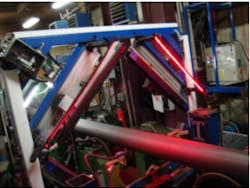Vision system detects cracks in steel
Engineers at Starmans Electronics (Prague, Czech Republic) have developed an automated system that used pulsed eddy currents and infra-red cameras to detect hidden and subsurface cracks in steel bars used in the automotive industry.
The system itself first wets the steel bars to ensure that the steel bars that pass through it will be heated in a homogeneous fashion. A large coil surrounding the bar then generates short pulsed eddy currents that heat the steel. Cracks and defects, if they are present, disturb the current flow and generate changes in the temperature profile where the cracks are located. The temperature changes are then captured using four infra-red cameras that are situated at each side of the steel bar.
After the acquired images have been captured, they are sent to a PC over a USB port where color images representing the different temperatures across the steel bar are displayed. The defects are then identified using an algorithm that can identify the higher temperatures in the images that represent the defects.
After the cracks have been identified, the system sends the data about the location of the cracks and defects to a database where they can be evaluated at a later date. In addition, the location of the cracks on the steel is highlighted by a marker at the end of the system.
The system has already been installed in one steel bar manufacturer where it is inspecting four meter steel bars in 20 seconds. According to the company, due to the sensitivity of the infra-red cameras, the system is capable of detecting a discontinuity with dimensions of less than 0.3mm. Once bars with defects are identified by the system, they are subsequently melted down by the manufacturer.
Related articles from Vision Systems Design you might also find of interest.
1. Bergy bits detected using thermal imaging
Thermal imaging cameras from Flir Systems (Wilsonville, OR, USA) have been demonstrated to be an effective way of tracking icebergs in the Arctic waters, helping seafarers to find the safest path through the ice.
2. Thermal camera helps analyze parts at over Mach 5
Manchester University (Manchester, UK) researchers are using a thermal imaging camera from FLIR Systems (Wilsonville, OR, USA) to examine the performance of aerospace components in a wind tunnel.
3. Thermal imaging detects wildlife in fields
Researchers led by PhD student Kim A. Steen at Aarhus University have developed a tractor-mounted system that uses thermal imaging and digital image processing to automatically detect animals during the mowing of a field of grass.
-- Dave Wilson, Senior Editor, Vision Systems Design
